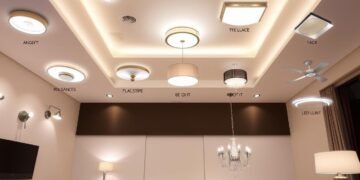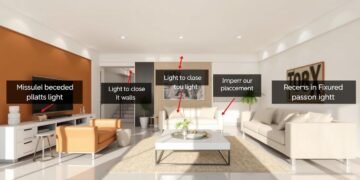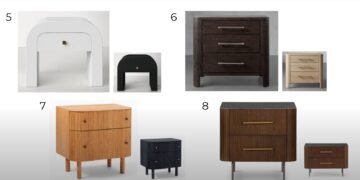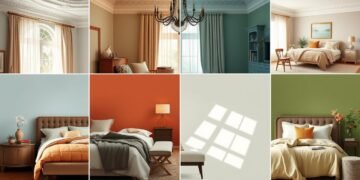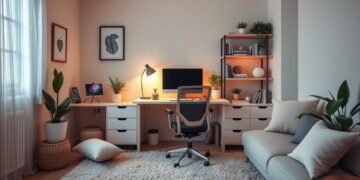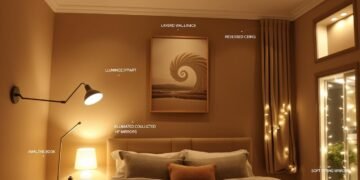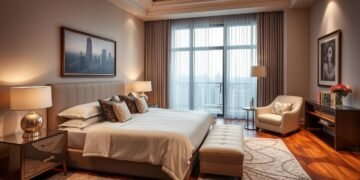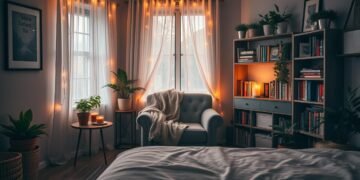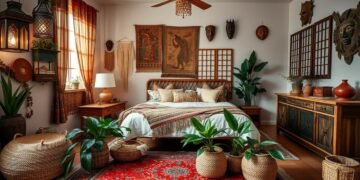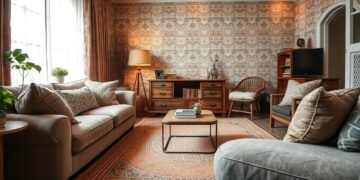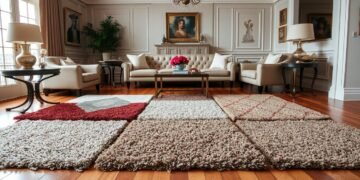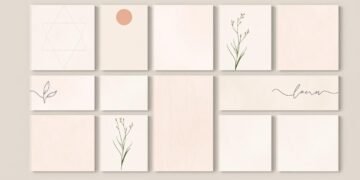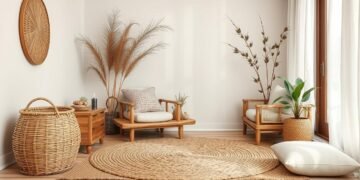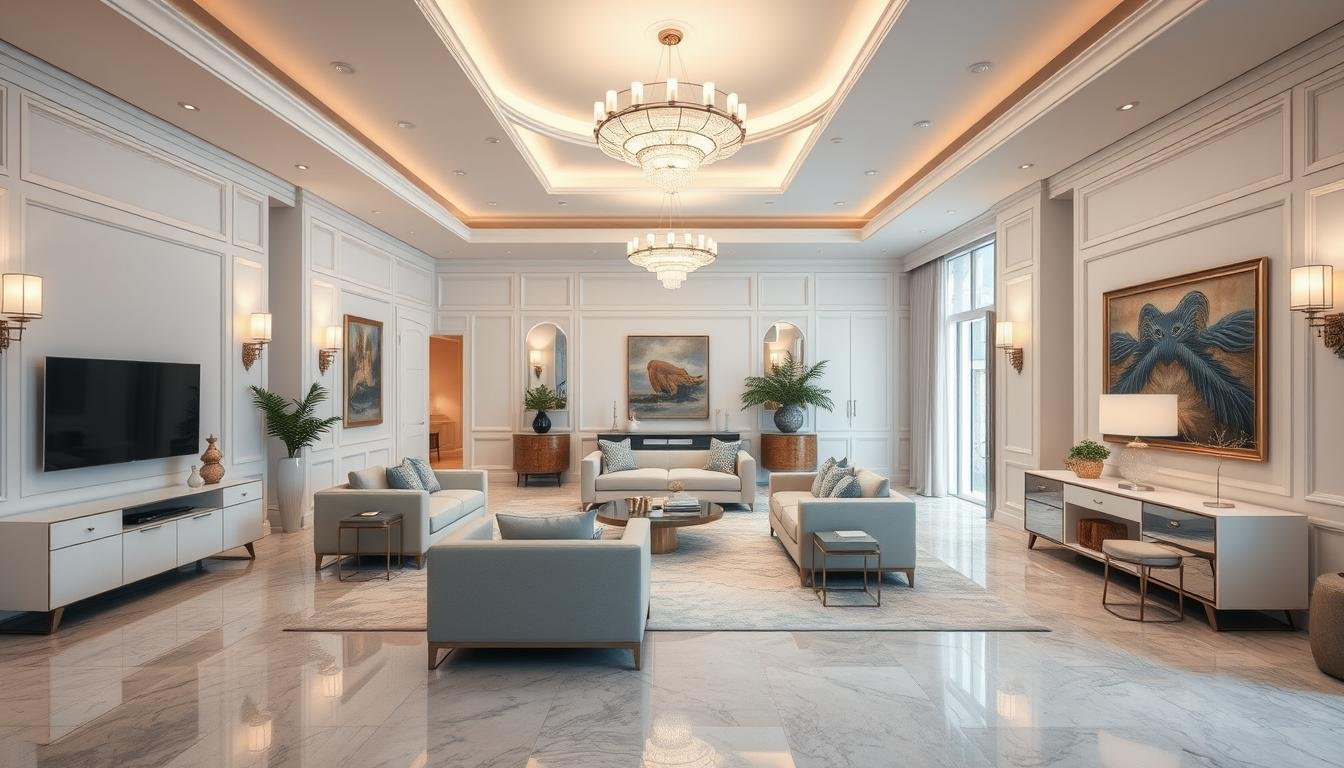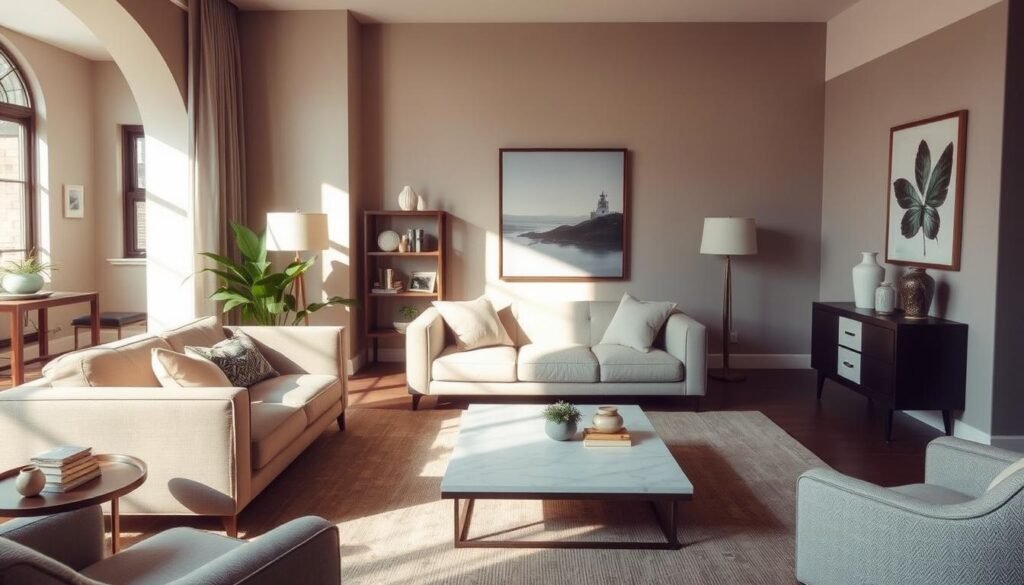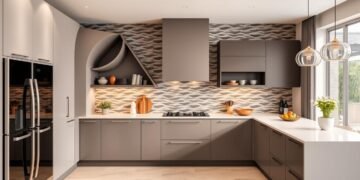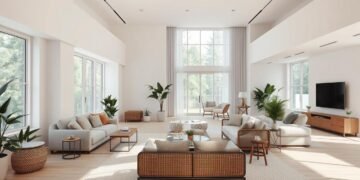As an interior designer, I remember a client’s living room that felt off. The furniture, artwork, and lighting didn’t match. It wasn’t until I stepped back that I saw the problem – a lack of proportion1.
Proportion in interior design is about balance. It’s not just size, but how sizes work together. This balance makes a room feel right or wrong1.
Many struggle with getting proportions right in their homes. In fact2, about 1 in 3 design mistakes are about scale or proportion. But, with a few tips, you can get it right and make any room feel perfect.
Table of Contents
- 1 Understanding Scale and Proportion in Interior Design
- 1.1 The Difference Between Scale and Proportion
- 1.2 Relatedarticles
- 1.3 8 Clever Ways to Introduce Rhythm and Movement into Your Décor
- 1.4 The 6 Simple Steps to Create a Harmonious Interior That Flows
- 1.5 7 Easy Ways to Achieve Perfect Balance in Your Home Décor
- 1.6 Why Proper Proportions Matter
- 1.7 Basic Principles of Visual Balance
- 2 The Golden Ratio: Your Secret Weapon for Perfect Room Design
- 3 Proportion in Interior Design: Essential Guidelines for Success
- 4 Mastering Furniture Placement and Room Layout
- 5 Art and Decorative Elements: Getting the Size Right
- 6 Lighting Fixtures and Their Proportional Impact
- 7 Creating Balance with Color and Pattern Distribution
- 8 Common Proportion Mistakes to Avoid
- 9 Working with Different Room Sizes and Shapes
- 10 Conclusion
- 11 FAQ
- 11.1 What is the difference between scale and proportion in interior design?
- 11.2 Why is proper proportion important in interior design?
- 11.3 What are some basic principles of visual balance in interior design?
- 11.4 How can the Golden Ratio be used in interior design?
- 11.5 What are some guidelines for achieving proper proportion with furniture and room layout?
- 11.6 How can you ensure proper proportions with wall art and accessories?
- 11.7 How do you choose the right size lighting fixtures for a room?
- 11.8 What are some common proportion mistakes to avoid in interior design?
- 11.9 How do you adapt proportion techniques for different room sizes and shapes?
- 12 Source Links
Key Takeaways
- Proper proportion is essential for creating visual harmony and balance in a space.
- 2An effective rule for artwork placement is that it should occupy at least 1/2 to 2/3 of the available space above furniture.
- 2Choosing a larger area rug can significantly enhance the perceived size of a room.
- 2Lighting fixtures, like chandeliers, should be at least half the width of the table or surface they’re illuminating.
- 2For overhead lighting, select a chandelier diameter equal to the combined length and width of the room in feet.
Understanding Scale and Proportion in Interior Design
Finding the right balance between scale and proportion is key in interior design. Scale is about the size of items compared to the room. Proportion is about how well different parts of a space look together3. Knowing these basics helps create spaces that look good and feel right.
The Difference Between Scale and Proportion
Scale is about making sure furniture and decor fit well in the room. Designers often use a rule where items are not bigger than ⅓ of the thing they sit on3. Proportion, though, is about how things look together, like the golden ratio of 1:1.618, which is pleasing to the eye3.
Why Proper Proportions Matter
Good proportions make a space look balanced and nice. Designers use the 60-30-10 rule to mix colors well, making sure everything fits together3. They also think about light, using mirrors or light colors to balance out the room’s lighting3.
Basic Principles of Visual Balance
To get visual balance, designers use the rule of thirds. This means grouping things in odd numbers for better flow34. They also divide spaces into ⅔ and ⅓ parts for interest and unity3. Using the human body as a scale helps make spaces feel comfortable and right.
Understanding scale and proportion helps designers make spaces that are both beautiful and welcoming. Learning these skills can take your interior design to the next level.
The Golden Ratio: Your Secret Weapon for Perfect Room Design
Creating harmonious proportions in interior design can change the game. The golden ratio, a timeless concept, is at the core. It has fascinated artists, architects, and designers for ages5.
The golden ratio, or the 2:3 rule, divides a room into a 3 x 3 grid. Furniture should take up about two-thirds of the space5. This ensures furniture fits well and creates a focal point, guiding the room’s visual flow5.
The golden ratio also guides color schemes. Decorate 60% of the room with a main color, 30% with a secondary, and 10% with an accent5. This balance makes the room appealing and cohesive6.
The Fibonacci sequence, linked to the golden ratio, aids in creating balanced designs. It applies to furniture and decorative elements6.
Using the golden ratio in design enhances aesthetics and functionality7. It helps achieve balance in rooms, whether with shapes, art, or lighting7.
The golden ratio is more than math; it’s a design strategy that can transform spaces. By embracing it, you’ll create rooms that are both beautiful and perfectly proportioned567.
Proportion in Interior Design: Essential Guidelines for Success
Creating the perfect balance in any room begins with understanding proportion. It’s about furniture size, color, and more. Mastering these elements is vital for a space that looks great and works well. Let’s dive into the key tips for achieving this.
Room Size and Furniture Relationships
Choosing furniture for a room means thinking about its size. The 2/3 rule is helpful for sofa and coffee table sizes, suggesting the coffee table should be two-thirds the sofa’s length8. This rule helps keep the room looking balanced. Also, using newspaper or cardboard to plan furniture layouts on the floor helps check if furniture fits right8.
Color Distribution and Visual Weight
Color in a room is key to good design. The 60-30-10 rule is a common guide, dividing color use into 60% main, 30% secondary, and 10% accent8. This rule helps create a balanced look. Also, thinking about the weight of colors and objects can help balance the room.
Architectural Elements and Space Planning
Adding architectural details like columns or moldings can improve a room’s look. These features add interest and depth, making the room feel balanced. Good space planning, like ensuring easy movement and function, also helps achieve a balanced design9.
By following these guidelines, you can make any space look and feel great. Remember, paying attention to details and balance is what makes a space proportional and beautiful.
Mastering Furniture Placement and Room Layout
Creating a balanced room starts with proportional furniture placement. It’s about matching the size of your furniture to the room’s size. This makes your space look good and work well10.
The Rule of Thirds is a great way to arrange furniture. It divides the room into thirds to place furniture. This makes the room look balanced and highlights important areas11.
It’s also key to make conversation areas. Keep chairs 8 feet apart for better talking. Also, leave 30-36 inches for walking to keep the room open and inviting11.
Identify the room’s main focus, like a fireplace or big window. Then, arrange furniture to highlight it. This makes the room look good and balanced11.
Using area rugs can also help. They define zones and add to the room’s look. They make furniture areas cozy and help the design flow11.
Learning about proportional furniture placement can make any room better. It’s about choosing furniture that fits well and looks good together. This creates a space that’s both beautiful and functional12.
Art and Decorative Elements: Getting the Size Right
Choosing the right size for your art and decor is key in interior design. It helps create a balanced and harmonious space. Understanding scale and visual hierarchy can enhance your design and make rooms feel welcoming.
Wall Art Sizing Guidelines
For wall art, aim for pieces that cover two-thirds to three-quarters of the wall above furniture. Grouping smaller artworks together can also create a larger visual impact, making them seem like one big piece13. When hanging multiple pieces, arrange them as a focal point for a balanced display.
Accessory Scaling Tips
Decorative accessories should match the size of the surface they’re on. Follow the rule of thirds, where the accessory occupies about one-third of the available space14. Using odd numbers of accessories adds balance and visual appeal14. Mixing heights and sizes adds depth and interest.
“Recognizing the Golden Ratio can help create proportional and visually appealing spaces, as objects following this ratio appear more harmonious.”13
By focusing on scale and proportion, you can improve your interior design. This creates a cohesive and stunning environment15. Balance and proportion are essential for a design that captivates and inspires.
Lighting Fixtures and Their Proportional Impact
In interior design, the right size of lighting fixtures is key. They should match the space well for perfect scale and harmony. The wrong choice can ruin a room’s look, so it’s vital to pick wisely16.
Lighting should fit the room and its furniture. For example, a dining room chandelier should be half to two-thirds the table’s width16. In bedrooms, lamps should match the nightstands and bed16. For living rooms, add the room’s length and width in feet, then convert to inches for the chandelier size16.
It’s also important to think about the architectural elements of the space. Lighting should add to the room’s beauty, not clash with it16. Choosing the right sizes can make your space look great and leave a strong impression.
When it comes to proportional interior lighting, details matter a lot. Paying attention to lighting sizes can make any space look better. It creates a beautiful and harmonious place to be.
Creating Balance with Color and Pattern Distribution
Finding the right mix of color and pattern is essential for a harmonious interior design. Understanding color proportion in interior design and visual proportion in textures helps create spaces that are both captivating and delightful. A key rule is the 60-30-10 color guideline:17
- 60% dominant color
- 30% secondary color
- 10% accent color
This rule ensures no color dominates, making your design cohesive and pleasing to the eye18.
In proportion in design patterns, varying scales and placements is key. Use large patterns on big surfaces like curtains or rugs. Medium patterns fit well on furniture, and small ones on accessories and textiles17.
Keeping a consistent color palette when mixing patterns is vital for harmony. Blending complementary colors and textures can enhance your space’s look and show off your style18.
Balance and symmetry are key to creating spaces that are both visually appealing and emotionally comforting. By mastering color proportion in interior design, visual proportion in textures, and proportion in design patterns, you can turn any space into a stylish and serene oasis19.
Common Proportion Mistakes to Avoid
Getting the right proportions in interior design is key to creating beautiful spaces. But, it’s easy to make mistakes that can ruin the look. Using the wrong scale can make rooms feel cluttered or cramped20. Mixing different sizes and shapes of items can keep a room interesting.
20 Keeping too many old items together can make a room look outdated20. It’s better to group accessories in small clusters and use odd numbers for a nicer look20. Big artwork can be the room’s centerpiece.
20 Using too many neutrals can make a space look dull without warm colors and textures20. Adding personal touches and avoiding trends can make a space unique20. Having a focal point in a room can make it more beautiful.
20 Using different lighting levels can make a room look balanced and nice20. Leaving space between furniture and walls can make a room feel bigger20. Choosing the right size rug is important for the room’s look.
20 Too many metals or bad space planning can mess up a room’s warmth and balance.
21 In Boca Raton, designers stress the need for planning and visualizing designs21. They use mood boards and sketches to plan rooms. Getting the scale right is important for comfortable and useful spaces.
21 Choosing the right lighting is key, with a mix of ambient, task, and accent lighting for the best look21. Designing for function is important, with good storage and furniture placement for comfort and practicality.
21 Color psychology is vital for creating harmonious spaces, with advice on choosing colors21. Paying attention to detail, like style and quality, is important for a cohesive look.
21 Adding personal touches to design is encouraged, with decor that reflects the owner’s style21. Working with a professional designer can help achieve a great design, using their expertise and creativity.
22 Many people struggle with finding the right size for furniture and decor22. About 70% of design mistakes are due to wrong proportions, like too small pictures or wrong hanging heights22. Hanging pictures at 60 to 65 inches from the floor is recommended.
22 It’s wise to get a designer’s advice before buying furniture, to avoid the wrong size22. Painting rooms first and then choosing fabrics is a common mistake22. It’s better to pick fabrics first and then match paint shades.
Working with Different Room Sizes and Shapes
Mastering proportional design is key, no matter the size or shape of your rooms. Whether it’s a cozy nook or a big great room, knowing how to use space can make any area look and feel great.
In small spaces, choose furniture that does more than one thing. Scale and proportion are important in design, making sure everything fits right in the room.23 Big rooms need big furniture, and small rooms need smaller pieces to keep things balanced.23 The right-sized furniture can make a room feel bigger and avoid a cluttered look.
For large rooms, break the space into zones to keep things cozy. Choosing the right furniture size can make a room feel more open; big furniture can make a big room feel cozy, and small pieces can make a small room feel bigger.24 Use rugs and group furniture to make different areas in the room.
In oddly shaped rooms, smart furniture placement can balance things out. Proportion is key to a balanced room, like a coffee table that’s about two-thirds the length of the sofa.25 Tall elements, like bookshelves or art, can help in rooms with high ceilings.
Whether your room is small, big, or shaped oddly, the secret to good design is to think about how the space and furniture work together. By following these tips, you can make your space look great and work well for you.
| Room Size | Proportional Design Considerations |
|---|---|
| Small Spaces |
|
| Large Rooms |
|
| Oddly Shaped Rooms |
|
“Proportion is a key element in achieving a visually balanced room design, such as aiming for a coffee table that is approximately two-thirds the length of the sofa.”25
Understanding proportional design helps you create spaces that look good and work well. It’s all about matching the size of the space with the furniture, making sure everything fits together perfectly. This way, you can make your space beautiful and functional, just the way you want it.
Conclusion
Learning about proportion in interior design is key to making spaces look good and feel right. It’s about knowing how to place things like furniture and decor. This way, you can make a space that looks good and feels comfortable26.
Use the Golden Ratio and Rule of Thirds to design rooms perfectly. Think about the size and look of furniture, colors, patterns, and accessories. This helps keep the space looking balanced and flowing well27.
Whether your space is big or small, getting the proportions right makes a big difference. It makes your space look nice and work well. By avoiding mistakes and following the right steps, you can make spaces that really stand out2627.
FAQ
What is the difference between scale and proportion in interior design?
Why is proper proportion important in interior design?
What are some basic principles of visual balance in interior design?
How can the Golden Ratio be used in interior design?
What are some guidelines for achieving proper proportion with furniture and room layout?
How can you ensure proper proportions with wall art and accessories?
How do you choose the right size lighting fixtures for a room?
What are some common proportion mistakes to avoid in interior design?
How do you adapt proportion techniques for different room sizes and shapes?
Source Links
- 5 important design principles that every interior lover should know
- Scale and Proportion In Interior Design | The DIY Playbook
- How To Use Scale and Proportion in Interior Design? | Foyr
- How to Use Proportion and Scale in Interior Design | Havenly Blog
- The 2:3 interior design rule is the pros’ secret weapon to creating an elegant living room – this is how the golden ratio works
- 13 Interior Design Tips for New Homeowners
- The Power of Geometry in Interior Design • VIZZZIO
- Proportion In Interior Design – Interior Design
- How to Use Proportion and Scale in Interior Design | DIY Home Comfort
- A Comprehensive Guide to Effective Room Planning
- Mastering Furniture Arrangement: Strategies for a Harmonious Living Space
- The Interior Design Institute
- Scale And Proportion: Your Key To Better And Easier Decorating
- Scale and Proportion in Interior Design | CHD Interiors
- Scale and Proportion: The Secret to Sizing in Interior Design — Ami Austin Interior Design
- Use of Scale and Proportion in Interiors – how to use it to your advantage
- Understanding The Seven Principles Of Interior Design
- How to Create Balance in Interior Design
- Symmetry and balance in interior design: the secret to perfect harmony – ALMA de LUCE
- 20 Common Interior Design Mistakes To Avoid in 2023 | Foyr
- Common Mistakes When Designing an Interior – Blog – Interiors by Brown
- Two Common Interior Design Mistakes to Avoid | Tuscany Fine Furnishings
- Playing with Scale in Interior Design – Stephanie Weitkamp
- Mastering Balance: A Guide to Scale and Proportion in Interior Design – Landry Designs
- Considering Shape, Size and Proportion | Hayward & Co.
- Implication of Scale and Proportion in Interior Design
- The Importance of Scale and Proportion in Interior Design – WeDezine-Blog




